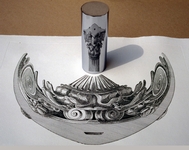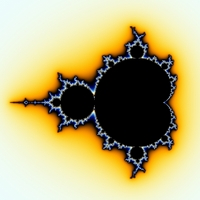| |
| 日本語 / русский / Português / Español / 简 体中文 / 繁 體中文 / Français / Nederlands / العربية |
Chapters 5 and 6: Complex NumbersMathematician Adrien Douady explains complex numbers. The square root of negative numbers is explained in simple terms. Transforming the plane, deforming pictures, creating fractal images. |
| To chapter 3 | To chapter 7 |
1. The presenterComplex numbers make up one of the most beautiful chapters in mathematics and have become an essential tool in the sciences. The path to their discovery was not an easy one, and terminology is part of the reason for this; they have been called "impossible" and "imaginary" numbers, and the word "complex'' gives the impression that they are not easy to understand. Happily this is not the case today: we can now present them in a relatively elementary way. |
|
Adrien Douady presents these chapters. An exceptional mathematician, he made a variety of contributions to the field, and he liked to say that all of his research centered on complex numbers. In particular, he was one of a group of mathematicians who revived the theory of complex dynamical systems, about which we will say more later. One of the characteristics of this theory is that it produces many beautiful fractal pictures, which can now be drawn, thanks to computers. Adrien Douady strongly encouraged these types of pictures, both to help mathematicians in their research and to popularize mathematics. We also owe to Douady a mathematical animation
titled The dynamics of the rabbit
(he liked to give
mathematical objects surprising names: rabbit, airplane, the cartoon
creature shadok, etc.) His recent passing profoundly saddened the
mathematical community. For some illustrations of his personality, see
this site
or this one (in French). |
|
It is clear that even Adrien Douady cannot explain the entire theory of complex numbers in 2 chapters of 13 minutes ... These chapters are not meant to be a substitute for a college level course, a book, or a detailed exposition (see for example this site or this one). One should consider these chapters as supplementary, as illustrations which encourage further learning or maybe as reminders of lessons forgotten long ago. Certainly the film tries above all to show clearly the geometric side of complex numbers. 2. Numbers and transformationsWe have seen that the line is one-dimensional, since we can place numbers on the line -- positive numbers to the right and negative to the left of the origin. Points are geometric objects and numbers are algebraic ones. The idea of thinking of numbers as points and points as numbers, that is to say, of mixing algebra and geometry, is one of the most fertile ideas in mathematics. As always, it is not easy to attribute this to one person, but it is generally Descartes to whom we attribute this powerful method of studying geometry by using algebra: this was the birth of algebraic geometry. If the points on a line are numbers, then we can understand geometrically the significance of the elementary operations between numbers: addition and multiplication. The key to this understanding is in the idea of a transformation. |
3. The square root of -1 |
|
For a long time, the impossibility of finding the square root of -1 was a dogma that could not be discussed. During the Renaissance, certain inventive spirits dared to break the taboo! If we dare to write √-1, then we can also write numbers like, for example, 2+ 3√-1, and we can also play with these numbers in the same formal manner without really trying to understand their meaning. These pioneers boldly went about making computations with these impossible numbers, in an almost experimental fashion. Since their calculations didn't seem to lead to any contradictions, these numbers were gradually accepted by mathematicians, without any real justification. The story of these numbers is quite long, and it is not our intention to describe the steps that led to their solid foundation. One can consult, for example, this page for a little history. It suffices to say, to simplify in the extreme, that at the turn of the nineteenth century several mathematicians, among them Gauss, Wessel and Argand, became aware of the geometric character of these imaginary numbers. The film shows a simplified presentation of a very simple idea of Argand. (Click on the image to the right to see Argand's original article. ) |
|
The number -1 is associated to the symmetry of reflection about the origin, that is to say a rotation by a half-turn. To find a square root of -1 is to find a transformation that, when performed twice in a row, gives a rotation by a half-turn. Argand declared therefore that the square root of -1 must be associated to the rotation by a quarter-turn, quite simply. Doing two rotations by a quarter turn gives a rotation by a half turn, that is to say, multiplying by -1. |
|
To summarize, Argand encouraged us to consider the points (x,y) in the plane not as a pair of (real) numbers, but rather as a a single (complex) number. This might seem very surprising, and perhaps artificial, but we will see that this idea is very powerful. 4. Complex arithmeticThe following is not difficult. After all these speculations, we have defined a complex number as being given by two real numbers, that is to say a point on the plane, and we denote it by z = x + i y. We are now about to show how to add two complex numbers, how to multiply them, and that all the properties of arithmetic that we are used to are still valid. For example, we have to check that the sum of complex numbers is the same no matter in which order they are added. All this can be done rigorously, but that's certainly not the point of this film ... Here is a presentation of the theory of complex numbers. For addition this is easy: we have the formula (x+i y) + (x'+i y') = (x+x')+ i (y +y'), so that addition of complex numbers comes down to adding the corresponding vectors. |
|
Two concepts are useful for what follows: The modulus of a complex number z= x +i y is simply the distance from the corresponding point (x,y) to the origin. We denote this by |z|, and it is equal by Pythagoras's Theorem to √(x2+y2) . For example, the modulus of i is equal to 1 and the modulus of 1+i is √ 2. The argument represents the direction of z. We denote it by Arg(z), and it is nothing other than the angle between the x-axis and the line joining the origin to (x,y). This argument is only defined when z is not zero. For example, the argument of i is 90 degrees, the argument of 1 is 0, of -1 is 180 degrees, and of 1+i is 45 degrees. Mathematicians for a long time tried to do the
same thing in dimension 3: how to multiply points in space? It took
them a long time to understand that this is not possible. In
4-dimensional space, they discovered that this was partially possible,
as long as one gives up the idea of a multiplication that satisfies ab=ba
! And they got so far as discovering that in dimension 8 it is still
possible, as long as one abandons the idea that (ab)c=a(bc),
before understanding around the middle of the twentieth century that,
other than in dimensions 1,2,4 and 8, there is absolutely no way to
multiply points ! To understand something about the preceding
mysterious sentences, see this, this
or this. In
summary, each point in the plane is defined by a single number - a
complex one. The plane which we have said is 2-dimensional
is now 1-dimensional! There is absolutely no contradiction here: the
plane has 2 real
dimensions but it is a 1-dimensional complex line. Real
plane, complex line ... 2 real dimensions, 1 complex dimension. Word
games? 5. Once again: stereographic projection! |
|
Recall stereographic projection: it transforms the 2-dimensional sphere, with the north pole removed, to the plane tangent to the south pole. As a point approaches the north pole, its projection moves away in the plane, so that we say it tends to infinity. Now, if we think of the plane tangent to the south pole as a complex line, we understand why the 2-dimensional sphere (2 real dimensions!) is often described as the complex projective line. There's a beautiful example of mathematical acrobatics: calling a sphere a line! Didn't Henri Poincaré say that mathematics consists in giving the same name to different things? |
6. Transformations( See the film: Chapter 6: Complex numbers, continuation ) This chapter proposes to give a little intuition for complex numbers by following certain transformations of the complex line. A transformation T is an operation that associates to each complex number z, that is each point in the plane, another point T(z). To illustrate, we place the picture of Adrien Douady in the plane and then show its image by the transformation: each pixel that makes up the portrait is transformed by T. Adrien chose several examples for the transformation T : T(z) = z/2 |
 |
For a long time, scholarly texts gave great importance to inversion, since it allows one to prove quite beautiful theorems. The principal property of inversion is that it transforms circles to circles or lines. Artists often use this type of transformation, and they've given it the name anamorphosis. |
|
More generally, if we choose 4 complex numbers a,b,c,d,
we can consider the transformation These transformations have several names in mathematics -- Moebius transformations, homographies, projective transformations -- but their principal property is that they send circles to circles or lines. This is the group of transformations of a magnificent geometry called conformal geometry, close to non-Euclidean geometry, but that's another story! |
|
T(z) = z+k/z |
6. Holomorphic dynamicsIn the second part of Chapter 6, Adrien Douady gives an introduction to a magnificent subject, in which he was one of the major contributors. It is about the study of Julia sets which, beyond their fundamental mathematical interest, are extraordinarily beautiful (and these two features are of course linked). It is rare that a powerful mathematical theory is illustrated in such a beautiful way, and a number of artists have been inspired by these images. |
 |
|
The starting idea is very simple: we choose an arbitrary complex number c. Then we consider the transformation Tc(z) = z2 + c. It acts first by squaring the number z and then by translating the answer by c. Starting at the initial point z, its transformed value is a point z1= Tc(z). From there we consider the transformed value of the transformed value z2= Tc(z1), and we continue towards infinity, producing a sequence zn of complex numbers where each number in this sequence is the transformed value of the preceding number. We say that the sequence zn is in the orbit of the initial point z under the transformation Tc. To study the behavior of the sequence zn, is to understand the dynamics of Tc . It comes down to a very simple example, but this example is sufficiently rich to give rise to some very beautiful mathematics. |
|
First consider the case where c = 0. This acts in effect by repeating the transformation Tc(z)=z2. The modulus of each zn is therefore the square of the preceding modulus. If the modulus of z is less than or equal to 1, that is if z is inside the disk of radius 1 centered at the origin, then all of the zn will stay in the disk. If, on the other hand, the modulus of z is strictly greater than 1, then the moduli of the zn will keep increasing and even tend toward infinity: the orbit of z will end up leaving the screen! In the first case, we say that the orbit is stable : it stays in a bounded region of the plane. In the second case it is unstable : it tends towards infinity. The set of points z for which the orbit is stable is therefore the disk. |
 |
We've known since the beginning of the twentieth century that the Julia set can be one of two types. It can have, as in the examples that we've just shown, a single component -- connected as mathematicians would say -- or else it is totally disconnected, consisting of infinitely many separate pieces, each having empty interior, that is to say we don't see them in a picture! Consequently, there are values of c for which we see the Julia set and others for which we don't see it at all (even though it exists). the set of values of c for which we see the Julia set (for which the Julia set is connected) is called the Mandelbrot set , in honor of Benoît Mandelbrot. Adrien Douady has done a lot of work to understand this set; he has for example contributed to showing that it itself is connected, and he would have loved to show (as would many others) that it is locally connected... |
|
The Mandelbrot set in the figure above has been
colored in this fashion, but there are dozens of other methods. In the
film, we use the method called "the triangle inequality'': when the
modulus of zn
becomes bigger than a certain value, we calculate the moduli A=|zn-zn-2|,
B=|zn-zn-1|
and C=|zn-1-zn-2|. Why at certain times do we have the impression of seeing new little black copies of the Mandelbrot set? That is much too difficult to explain, and that is one of the important discoveries of Adrien Douady: the Mandelbrot set has the property of self-similarity, a frequent characteristic of fractal sets. To better understand this, see for example this page.
|
| To chapter 3 | To chapter 7 |